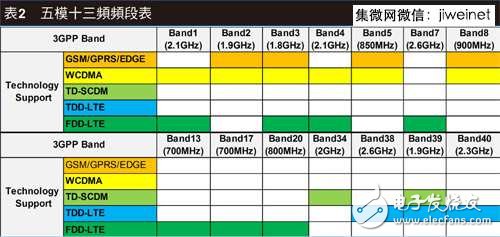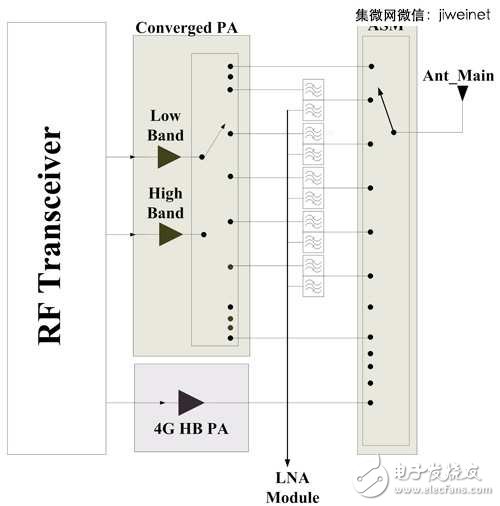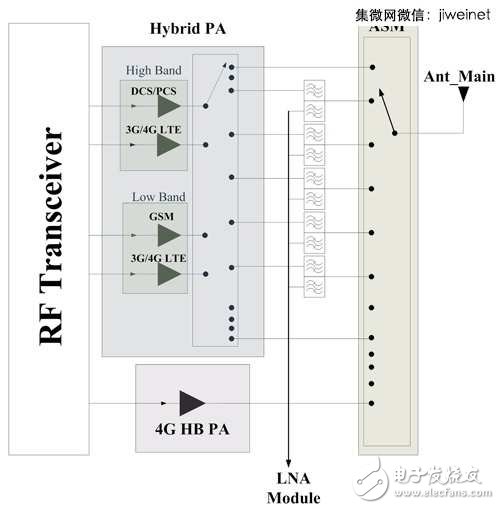LTE/11ac leads the trend, resulting in continuous updating of mobile phone RF front-end design
The Internet of Things (IoT)-driven issues continue to generate fever in a variety of formal and informal settings at home and abroad, and people are injecting more imagination into ubiquitous smart products, or so-called smart applications. In recent years, under the pressure of saturated market, all walks of life hold the hope that the next generation of Embedded Intelligence products will come soon.
Nowadays, as long as any object is "smart", people will rush. Smart Objects in the architecture of the Internet of Things means that people can use smart products anytime, anywhere, and enjoy the fruits of intelligence. When cost-effective smart products change people's lives and even rely on it, the huge growth of the market scale is predictable. This is also the cornerstone for the growth of the IoT upstream, middle and downstream manufacturers to pursue growth.
The intelligent elements of the Internet of Things come from the automatic communication of Machine to Machine (M2M), as well as the wireless transmission and network computing of a large amount of information, from the origin of the event to the clever presentation of the event results, in line with people's solution to the event. Look forward to at the same time minimizing inefficient intervention. The mutual communication between hundreds of millions of machines, as well as the transmission of a large amount of information and the calculation of data in the cloud, must rely on a reliable infrastructure to complete interface conversion and information distribution in an instant and without error.
At this stage, it supports infrastructure such as 3G/4G Long Term EvoluTIon (LTE), wireless area network (Wi-Fi)/802.11ac, and meets the wireless communication standard terminal products, including smart phones and wearable devices. Wireless network cards and smart home products, these products will also inject the challenges and visions of technological innovation and intelligent functions with the high-speed, high-frequency and high-efficiency essential requirements of the Internet of Things.
Dismantling and supporting 4G/LTE, Wi-Fi/802.11ac intelligent wireless terminal products, such as innovative technologies of smart phones, radio frequency front-end modules (RF FEM), will also be the so-called intelligent Key technologies that are unbounded, efficient, and cost-effective.
Achieve global seamless connection mobile phone support multi-mode / multi-frequency into the key
The standardized specifications of LTE and Wi-Fi/802.11ac make the most predictable dawn of the consumer market by combining IoT applications related to smart phones. Built-in 4G LTE and 802.11ac standardized smartphones, Seamless ConnecTIvity supports the basic features of Ubiquitous Networks, while providing intelligent personal and family-related broadband audio and video control application.
The recommended frequency of 4G LTE is as many as forty-four. According to different national conditions, the frequency bands used are also different. In order to communicate with the traditional 3G and Global System for Mobile Communications (GSM), a global seamless connection is made and traveled. In each frequency band, it has a multi-mode (MulTImode) and multi-frequency (MulTIband) architecture, which has become a key technology for mobile phone RF front-end.
Under the limited spectrum resources and relatively high usage rates of various countries, the demand for high transmission speed with high-performance digital modulation technology is the standard of LTE and Wi-Fi/802.11ac Air Interface. However, such a technology will generate a Peak to Average Power Ratio (PAPR) of the degraded signal, increase more power consumption, and reduce the battery efficiency of the mobile phone. Envelop Tracking (ET) technology, which reduces the power consumption of RF front-end components, has become a key indicator of a new generation of smart phones, with the improvement of green energy awareness and the demand for mobile phone use.
Under the guidance of LTE mobile communication and Wi-Fi/802.11ac wireless network, the refurbished multi-mode multi-frequency RF front-end design will drive smart phones and related wearable devices closer to the IoT smart objects and intelligence. End products.
Multi-mode multi-frequency RF front-end requirements
Supporting LTE smartphones without borders, considering the power consumption and compact appearance, the multi-frequency multi-mode RF front-end design is the only option. Look at global RF front-end component manufacturers such as Skyworks, RFMD, Anadigics and RichWave, and even Qualcomm, which is actively involved in integrating main chips and RF front-end modules, when these products are being developed. All aim to support multi-mode multi-frequency design.
In summary, 4G/LTE smart phones support five modes, namely, Frequency-Division Duplex (FDD)-LTE, Time-Division Duplex (TDD)-LTE, and Time-sharing Synchronization. Code Multiple Access (TD-SCDMA), Wideband Coded Multiple Access (WCDMA) and GSM. In addition, multi-frequency (determined by the operating band of the region and operator) and global roaming are already the operators and consumers of all countries. basic needs.
The European Telecommunications Standards Institute (ETSI) defines the four-fourth frequency range of 4G/LTE in the technical document 3GPP TS 36.101. The band 1?32 is frequency division multiplexing and frequency band 33?44. For time-multiplexed, the detailed frequency distribution of each LTE band can be referred to Table 1.

The mobile phone RF front-end module mainly includes mobile communication LTE related RF components, such as Antenna Switch Module (ASM), Power Amplifier (PA), Duplexer (Duplixer), Surface Acoustic Wave Filter (Surface) Acoustic Wave Filter, SAW), Film Bulk Acoustic Resonator (FBAR) filter, RF front-end components related to wireless network Wi-Fi/802.11ac and Global Position System (GPS). Obviously, the innovative design of the power amplifier in the RF front-end component directly affects the detailed structure of the RF front-end of the mobile phone.
The power amplifier is evolved into a Quad-band (GSM/General Packet Radio Service) that provides a single-mode function of the Constant Envelop single mode function for 2G mobile communications. GPRS)/GSM Enhanced Rate Evolution (EDGE) power amplifier chip module, further supported by 3G mobile communication single-mode linear power amplifier, further evolved to provide LTE air interfacing, and backward compatible with multi-band multimode Multi-mode power amplifier (Multimode Multiband PA, MMMB PA).
Multimode multi-frequency power amplifier architecture
In recent years, RF front-end module suppliers have several multi-mode multi-frequency power amplifiers with different functions in the mobile phone market to provide platform design reference for system chip vendors, or customized by original design manufacturers (ODMs). Suggest. Basically, multimode multi-frequency power amplifiers can be divided into single-mode power amplifiers (Single-mode PA), fused mode power amplifiers (Converged-mode PA), and hybrid mode power amplifiers according to their supported communication modes (Hybrid -mode PA), these three modes of power amplifiers have different considerations in terms of performance, board area and price.
Supports GSM/GPRS/EDGE quad-band (800/900MHz and 1800/1900MHz) power amplifiers, and supports 3G/4G LTE single-mode single-band power amplifiers, which is the most commonly used single-mode power amplifier in the market. 1 is a block diagram of a typical mobile phone RF front end composed of a single-mode power amplifier.
Figure 1 Block diagram of the mobile phone RF front end composed of a single-mode power amplifier
The multi-mode multi-frequency RF front-end architecture consists of an antenna switch module, a 2G/2.5G quad-band power amplifier, and five to six single-mode 3G/4G LTE power amplifiers that support five-mode thirteen-frequency (Table 2). ) Global roaming capabilities. This single-mode, single-frequency power amplifier has the best power-added benefit at a given specification of the output power due to its optimized design for a specific frequency band and load-line (Load-line). (Power Added Efficiency, PAE).

Although the single-mode power amplifier solution can provide better transmit performance, the number of power amplifiers increases with the frequency band used, and different numbers of power amplifiers must be used in different regions, plus a large printed circuit board area and complicated wiring. It is impossible to use one version of the product, which results in difficulty in designing the mobile phone, and the cost of materials and PCBs.
The fused mode power amplifier, as the name suggests, is designed with a single power amplifier for multiple communication modes. The RF front-end architecture consisting of a fused-mode power amplifier will further reduce the number of power amplifiers used.
Taking Figure 2 as an example, using only two fusion mode power amplifiers to replace the 2G/2.5G quad-band power amplifier and five to six single-mode 3G/4G LTE power amplifiers, significantly reducing the cost of materials and PCB layout. area. Therefore, the multi-band multi-mode RF front-end architecture consisting of a fused mode power amplifier can effectively reduce the cost of mobile phones and the complexity of PCB layout. The shared PCB design can also shorten the development time of new mobile phones.

Figure 2 Multimode multi-frequency RF front-end architecture consisting of a fusion mode power amplifier
However, power amplifiers with multimode multi-frequency fusion mode in RF performance are still not designed to be optimized. The 2G/2.5G minimum frequency shift keying (GMSK) signal feature is a fixed packet, 4G/LTE 16 Quadrature Amplitude Modulation (QAM) signal feature Non-constant Envelope, both in the power amplifier The design of the bias operating point, load impedance and matching circuit are quite different. For example, if the output stage transistor size of the output GSM 35dBm power amplifier is the same as the matching circuit and operates at LTE 27dBm output power, the PAE is not obvious. In summary, the multi-mode multi-frequency fusion mode power amplifier has different performance differences in working in different modes, and cannot achieve the optimal design of power added benefit in multi-mode operation.
Another hybrid mode power amplifier (Hybrid-Mode PA) solution architecture can refer to Figure 3, although slightly increasing the PCB size and the number of power amplifiers, but if you can improve the shortcomings of the fused mode power amplifier, it will It is another design that considers a reasonable price/performance ratio.

Figure 3. Multimode multi-frequency RF front-end architecture consisting of mixed-mode power amplifiers
The mixed mode multimode multi-frequency power amplifier is divided into four power amplification paths according to the specifications of its frequency band and linearity (2G/2.5G or 4G LTE), and the two power amplifiers provide 2G/2.5G high. The High Band and Low Band are used, and the other two power amplifiers provide high frequency and low frequency bands for 3G/4G LTE. The four-way power amplifier can optimize the power transistor size and matching circuit according to the frequency band and linearity of its operation.
The multimode multi-frequency RF end-of-band architecture of the hybrid mode power amplifier is superior to the RF front-end architecture of the fused mode power amplifier in terms of RF performance, and can also be comparable to the RF front-end architecture composed of a single-mode power amplifier. In terms of PCB area, it is necessary to increase the size of the power amplifier chip and the area of ​​the PCB. However, with the evolution of the system chip package miniaturization technology, the limited area increase has become a market trend.
Icicle & Curtain Lights
The curtain light is mainly composed of a light string and a fixing hook; the light string is formed by connecting light bulb and wire; the fixing hook is a fitting having a wire groove and a hook, and the hook is formed above the wire groove. According to a certain shape, the wires on the light string can be fixed in the wire trough, so that various styles of curtain lights can be assembled., and the whole curtain light can be hung on the frame of the window and door through the hook when in use, and with the light bulb on the light chain to achieve the effect of dressing up windows and doors.
Usage one of Curtain lights: decorative bedroom
In fact, curtain lights are generally made up of a combination of small light strings of different colors, so you can transform a lot of shapes, decorate in all aspects, you can choose a part of the curtain light string, hanging on both sides of bedroom curtains and bedroom door, the ceiling can also be combined with some romantic patterns, and if the light selection is softer, it must very beautiful when the advent of the night lights come on.
Usage two of Curtain lights: decorative bed
The curtain and the bed curtain have similar effect , it can be operated if your bed with a bedpost or a bed curtain, if all the light string of the curtain light are hung on the bed or mattress, or directly take the light as a curtain and it looks like a waterfall when turn it on at night .
Usage three of Curtain lights: decorative wall surface
Curtain lights can be used to decorate walls, it is not only simply hanging on the wall as decoration, but also can be decorated with some murals or room structure, even it can be combined into a pattern or letter and so on. It is convenient to operate and very innovative.
Usage four of Curtain lights: decorative windows
The curtain lights is playing a major role to decorate windows, but the new method certainly not an ordinary decoration, it not only can be decorated on the window frame, but also can use as curtain, and it can sew special pattern on the curtains, then a beautiful pattern will be appeared when you draw the curtain at night.
Usage five of Curtain lights: decorative items
There are several kinds of items in the family unused and not pretty, and the key is that they are indispensable items. Such items are often incongruous in space and obtrusive, so you can use the curtain lights to decorate them, to wrap around them to create different scenery, like some toys can also be decorated.
Usage six of Curtain lights: decorative balcony
The monotonous balcony can also be very romantic. Choose star-shaped curtain light to decorate on the side of the balcony or on the balcony of the plant. Such a balcony is very special.
Icicle & Curtain Lights,LED Rubber Icicle Light,LED Mesh Lights,LED Net Curtain Light
Heshan Jianhao Lighting Industrial Co., Ltd. , https://www.sunclubtw.com